Advanced Breast Cancer Survivor
Creativity Sparks Emotional Healing
 Sharon Chappell responded to a breast cancer diagnosis at 44 with an intense burst of creativity that has helped her and her family manage her cancer treatment. She regularly writes poetry and makes hand-lettered art. She has also drawn from her own cancer experiences to write “The Little Green Monster,” a children’s book designed to help other families break down the fears about treatment and navigate the world of cancer.
Sharon Chappell responded to a breast cancer diagnosis at 44 with an intense burst of creativity that has helped her and her family manage her cancer treatment. She regularly writes poetry and makes hand-lettered art. She has also drawn from her own cancer experiences to write “The Little Green Monster,” a children’s book designed to help other families break down the fears about treatment and navigate the world of cancer.
The lump I felt during a self-exam in August 2017 felt different from others I’d felt before. This was hard like an eraser and didn’t move or shift at all. My annual mammogram was set for September, so I waited for that. The results were inconclusive, and my doctor ordered an ultrasound. The radiologist onsite wanted to do a biopsy. He prepared me for the loud noises I’d hear, which sounded like shots from a pop gun, while he took five samples.
Shortly after, my husband, our 11-year-old daughter and I took a trip to adopt a parrot. We were having lunch on a veranda in Arizona when I got the call that three of the five samples were cancerous. I used the only thing I had to write with – a red crayon – to frantically note everything my doctor said, including my diagnosis: invasive ductal carcinoma.
I chose a breast cancer surgeon with 20 years of experience who came highly recommended. She worked in a hospital with a new radiation oncology clinic, which was also close to our home. I was pleased with her. I had a lot of anxiety at first, and she was very responsive on both a medical and emotional level. She really took her time with me and addressed all my questions and fears.
She recommended genetic testing and determined that I did not have any markers that would direct my treatment for my type of breast cancer, ER+/PR+/HER2-.
In December, I had a lumpectomy, and nine lymph nodes were taken out. Four were cancerous. I had an axillary lymph node dissection in January. Ten more nodes were removed, and five were cancerous. My surgeon staged the breast cancer as Stage III.
The hospital assigned me an oncologist who recommended five months of chemotherapy to be followed by six weeks of radiation and then extended hormone therapy. To prepare for chemotherapy, I had a port surgically inserted. It became infected and had to be removed. I did daily wound care for about six weeks. Because I couldn’t use the port, I had chemotherapy by IV. I have a few good veins that we rotated, and I drank a lot of water before each infusion.
When I began to lose my hair as a result of the chemotherapy, my daughter worried that I wouldn’t be “Mommy” anymore. I explained that it meant the medicine was working. She helped shave off the rest of my hair. She is my “creative consultant” and has been very involved all along the way. The day before my first chemotherapy infusion, we prepared for the day by wearing red wigs and roller skating.
We are all in counseling to help us process the disease’s effect. Our daughter’s therapy includes expressive arts and play therapy, and we do a lot of cuddling and storytelling activities at home. She has many questions about my condition. Kids are resilient, especially when you do a good job of communicating with them. She is amazing.
I write poetry as often as possible, and I use visual and written imagery to help me see the good in the tough things. For example, some people refer to a certain type of chemotherapy as the “red devil.” I envision it as something red but positive, like fruit punch or a healing elixir. I’ve also written a children’s book called “The Little Green Monster.” Through the little green monster’s imaginative adventures, such as checking in at the clinic, getting an IV and talking to nurses, he helps the daughter in the story handle the effect of cancer on her life. My hope is that the book breaks down stigmas surrounding cancer and helps children understand a range of emotions, such as that not everyone affected by cancer is unhappy all the time. The book contains art and writing activities. It is a labor of love. We fundraised to be able to print it and are donating as many copies as we can to families, local treatment centers, libraries and schools.
My husband bears the brunt of caregiving. It’s hard to anticipate my side effects and the things I’ll need from day to day. We show a lot of grace to each other, and I’m very appreciative of him. In fact, I try very hard to show my appreciation to anyone who helps me. I give my poetry and art to them.
There are many challenging parts of having cancer, such as fatigue, isolation and loneliness. It helps if you can find what you feel is beautiful about life. I take long walks, and I try to be mindful and see how wonderful every day is. It’s my way of embracing my fresh start.


